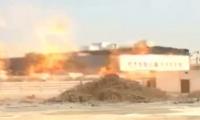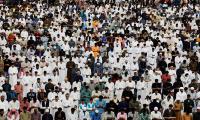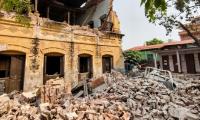Mashal Khan’s murder shook many of us to the core. And how could it not? A young man of just 23 years was brutally beaten to death in a display of cruelty that is hard to explain. That it happened at an institute of higher learning, and was led by students, adds to the horror induced by this event. A country that used the trope of “educating the children of the enemy” to overcome the trauma of the APS massacre now realises that educational institutions themselves are also producing the enemy.
As our mourning turns into rage, we are left with little choice but to try to coldly analyse the historical reasons that have brought us to this sorry situation, -- so that we can understand how to begin imagining an authentic departure from this seemingly never-ending cycle of violence .
The first point to grasp is that the accusations of kufr/blasphemy are not innate to either the cultural or religious essence of this region. The anxiety over who is a Muslim (or even Hindu) began with the classificatory techniques used by the colonial state to define its subjects in broad, homogenous categories. Many of the syncretic traditions found in local cultures, however, did not allow for such neat demarcations that the state desired. Yet, these demarcations were necessary for 19th century colonial governance, especially for quotas, electoral seats and other resources to be distributed among different segments of population.
One of the responses to the pressure of demographics was the emergence of reform movements that aimed to purge ‘non-Islamic’ rituals from the practices of Muslims. The aim was to bring forth a narrow definition of Muslim, so that reformist leaders could legitimately claim to speak on behalf of the Muslim community and consolidate their numbers. The problem, however, was that the colonial era witnessed the growth of numerous proponents of Islamic reform, with each group claiming to be the ‘true’ representative of the community. Thus, the debates between leaders of modern Muslim sects were sometimes as divisive as their debates with Hindu and Christian leaders, the former often over the precise definition of who was to be excluded (rather than included) from the Muslim community.
After Partition, with the Hindu ‘enemy’ removed, internal strife over the spiritual and political leadership of the Muslim community took centre stage. The process of internal purging to reach the ‘essence’ of the community proved to be an unending process, with different groups claiming to speak on behalf of the ‘Muslim nation’.
The biggest casualty of the politics of suspicion was that religion no longer remained a private, intimate, and at times transgressive, relation between human beings and the Divine. Instead, it was to be either sanctioned by the state bureaucracy through laws, identity cards or passports, or it had to be demonstrated publicly through ritual to satisfy the intrusive gaze of a suspicious public.
It is also crucial to recognise the power politics and elite interests at play in this process. The key to understanding spectacular forms of violence, such as the one in Mardan, is that they are never spontaneous. Rather, they are predictable, either in the immediate sense or in a more structural sense. In the former case, it is often individuals aligned with powerful groups who instigate, mobilise and channel the crowds in a cold, calculated manner.
On the other hand, we witness mob violence that may actually give the appearance of an immediate, contingent issue, without a central plan. Yet, such violence is made possible by the state infrastructure that manufactures rage over certain issues, and provides immunity to those who commit violence as a consequence of that rage. In other words, they set the conditions in which mob violence becomes not only possible but probable.
The structural aspect of such violence is proving to be extremely resilient, even in the face of Pakistan’s 15-year participation in the ‘war on terror’. Extremist groups have kept their educational apparatuses remarkably intact, not to mention that they have considerable influence over public curriculum. Politicians, state officials and the media either support this ideology or find it irrelevant to confront in their larger pursuit of political power.
The reason progressive groups, including political parties and liberal activists, are unable to withstand the onslaught of religiously motivated mobs is not simply because of the numbers or the passion involved. In fact, one can easily argue that those who fought for democracy and regional/ethnic rights have moved millions of people throughout our country’s history and have given immense sacrifices for the causes they believed in. Yet, while progressive activists are demonised as treacherous by the state and their organisations on campuses are banned, religious groups are allowed to organise with impunity. In other words, while extremist forces are encouraged to propagate their views, the state’s suppression of forces who could resist them have made the latter toothless.
We now have a situation in which the Right has accumulated power through the support of the state, and through educational and media apparatuses, while those opposing them remain disorganised. The field is now open for spectacles of violence to be carried out by the religious right, not because they can justify it but because they don’t need to any longer. This is raw and brutal power on display.
The issue of blasphemy has become the site for the most intense convergence of two trajectories in our history: the suspicion aroused as part of the impossible desire for a unified definition of a Muslim, and the accumulated power of the religious right that aims to eliminate any challenge to its power. The politics of suspicion provides the hysterical impulse toward controversies regarding religion, while organised political groups provide it with the precision of target to wipe out any potential adversaries. The result is a combination of horror and helplessness that we continue to experience with each spectacle of violence.
Perhaps the indescribable scenes of violence in the video footage of the incident should now give us the impetus to demand the impossible -- a de-linking of religion and state power. This is not only an attempt to permit the state to confront the planned and recurrent mob violence so that it can save whatever is left of its social contract with the citizenry. It is also a plea to save religion from the machinations of power, from its reduction to lifeless statistics on a bureaucrat’s file, from its murderous deployment by groups pursuing political interests. Religion in today’s Pakistan has, rather than providing an anchor in a disenchanted world, become another symptom of our fragility and another tool for the cynical exercise of power, only more brutal in its effects.
Despite the gloom of the past few weeks, there is perhaps a silver lining. The breathtakingly dignified response to Mashal’s death displayed by his parents, and their powerful suggestion to change curriculum, struck a chord with many across the country. Moreover, the protests against Mashal’s killing in his native town also appeared as one of the most heart-warming, if not heroic, sights of our times. To have such a public display of support for a victim of blasphemy accusations was unimaginable a few years ago when the governor of the most powerful province in the country was shot with precious little resistance to the narrative provided by the forces who had murdered him.
The task ahead is difficult, since we must not only propose a different relation between state, religion and the citizenry, but must also think of ways in which we can accumulate power to stand our ground against retrogressive forces. But this is a task that can no longer be ignored since the very future of our country now depends on finding new horizons, as the old ones have given us little more than grief, fragility and violence. Courage to find the new -- despite what state, society or even our old selves think of us -- is what we owe to the victims of religiously motivated violence, past and present.
Transforming fear with courage, and an impasse into a possibility, will be the greatest tribute we can possibly pay to the sacrifice rendered by Mashal Khan.
The writer is a doctoral candidate at the University of Cambridge and a lecturer at the GovernmentCollege University, Lahore.
Email: ammarjan86@gmail.com
Critics argue that strategy is vague, but closer look indicates strategic alignment with global trends and national...
To defeat it, we must distrust bot-driven narratives, to defeat it, we must verify sources before believing or sharing
Too often in emerging markets, digital innovation is treated as standalone goal, with risk relegated to afterthought
As in Pakistan lawfare’s impact and prevalence are increasing, situation is turning murkier
Number of traditions are associated with Eid, such as new clothes and giving and receiving of cash gifts as Eidi
Internationally, there have been misleading theories propounded about so-called slowing of Chinese economy







